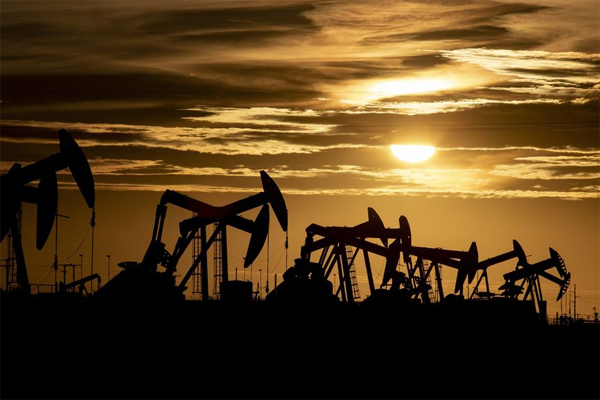The crash of 2020 and the pressure of climate-change politics led them to reconsider their business models.

By Paul H. Tice
On the back of Russia’s invasion of Ukraine, crude oil prices jumped above $100 a barrel, and the average cost of U.S. gasoline has surpassed $4 a gallon. Yet domestic oil production has barely budged over the past two years and remains stuck below 12 million barrels a day, 10% to 15% below the pre-pandemic high.
The total U.S. oil rig count has bounced back, but only to roughly 75% of the recent peak in March 2020. Major U.S. shale producers, particularly ones in the Permian Basin of Texas, have a break-even oil price close to $30 a barrel, so why isn’t American supply responding to price signals from the global market?
First and foremost, U.S. shale got a wake-up call about its business model in 2020. That’s when the combination of an OPEC+ oil-market-share battle and pandemic lockdowns briefly turned crude oil prices negative and decimated the energy sector, driving more than 100 North American oil and gas companies into bankruptcy by year end.
After largely giving lip service to shareholder activists following the 2014 shale crash, almost every U.S. energy company has also embraced the need for capital spending restraint and generating free cash flow rather than simply expanding production. Flat or up slightly (5% or less) is the new production growth paradigm, and living within cash flow is paramount. This fiscal discipline held through 2021 even as crude oil prices doubled and continues to hold despite a roughly $30-a-barrel price jump since the beginning of 2022.
Last year energy rebounded from the annus horribilis of 2020 and became the best-performing sector in the U.S. equity and debt markets. Energy-company management teams don’t want to rock this boat, especially given regulatory clouds looming over the industry.
Feeding into the U.S. industry’s self-imposed choke valve on aggregate oil volumes is the outlook for restricted drilling growth and market access in coming years, which is where the Biden administration’s anti-fossil-fuel policies come into play.
U.S. oil and gas producers need to extend their drilling inventories and permit runways further into the future because the Biden White House is canceling or slow-walking leases on federal lands while clawing back acreage for national monuments. The administration also is taking advantage of environmental and endangered-species statutes to curtail drilling on private land. New energy infrastructure projects—including interstate pipelines and liquefied natural gas export facilities—are subject to a global climate test, a charge for the social cost of carbon and environmental-justice standards. All this will have a chilling effect on new projects and further reinforce industry consolidation.
The main risk to the industry over the next decade is not the potential for oil and gas demand to go down because of the global energy transition away from fossil fuels. It is the high likelihood of more energy supply-chain bottlenecks created by government officials. A supply-constrained scenario would be bullish for oil prices, giving producers even more incentive to keep hydrocarbon reserves in the ground now to produce them at higher realized prices down the road. As seen by the four legally paralyzed years of the Trump administration, even if Republicans regain the White House in 2024, not much would change with regard to the inexorable march toward 2030, the year of the climate rapture set by the United Nations.
U.S. energy companies have begun to wise up to the threat that the theory of man-made climate change poses to the industry. Since the Paris Agreement’s signing in 2015, the global goal of decreasing carbon emissions has provided moral justification for an all-out regulatory assault.
The latest front is the sustainable-investment movement sweeping Wall Street, which has climate action as its top environmental, social and governance objective. U.S. and European financial regulators are pushing through mandatory reporting standards on sustainability. This is the first step toward screening and excluding politically incorrect industries such as oil and gas from investment portfolios. As the intertwined climate-change and sustainability movements gain momentum between now and 2030, the lending and capital markets are likely to become more hostile toward traditional energy.
U.S. shale companies will need to ensure their ability to self-fund from operations and run with less balance-sheet debt to reduce their dependence on financing from the banking system and institutional investors. Consequently, corporate sustainability doctrine provides another strong argument for U.S. energy companies to maintain the status quo of slow to no production growth and to continue living within cash flow over the long term.
Ironically, all the defensive measures now being taken by the U.S. shale industry make it more attractive—and sustainable—from an investment perspective. On top of production and spending discipline and stronger energy commodity prices, some shale players are merging to build critical mass, both in operating scale and financial-market capitalization.
So why aren’t American oil and gas companies producing more barrels to help tamp down oil and gasoline prices during a global market shock when domestic inflation is rampant? The answer, as with everything that revolves around climate change, is complicated.
_____________________________________________________________
Mr. Tice works in investment management and is an adjunct professor of finance at New York University’s Stern School of Business. Energiesnet.com does not necessarily share these views.
Editor’s Note: This article was originally published by The Wall Street Journal-WSJ on March 15, 2022. EnergiesNet.com reproduces this article in the interest of our readers. All comments posted and published on EnergiesNet.com, do not reflect either for or against the opinion expressed in the comment as an endorsement of EnergiesNet.com or Petroleumworld.
Use Notice: This site contains copyrighted material the use of which has not always been specifically authorized by the copyright owner. We are making such material available in our efforts to advance understanding of issues of socially, environmental and humanitarian significance. We believe this constitutes a ‘fair use’ of any such copyrighted material as provided for in section 107 of the US Copyright Law. In accordance with Title 17 U.S.C. Section 107. For more information go to: http://www.law.cornell.edu/uscode/17/107.shtml.
EnergiesNet.com 03 17 2022












